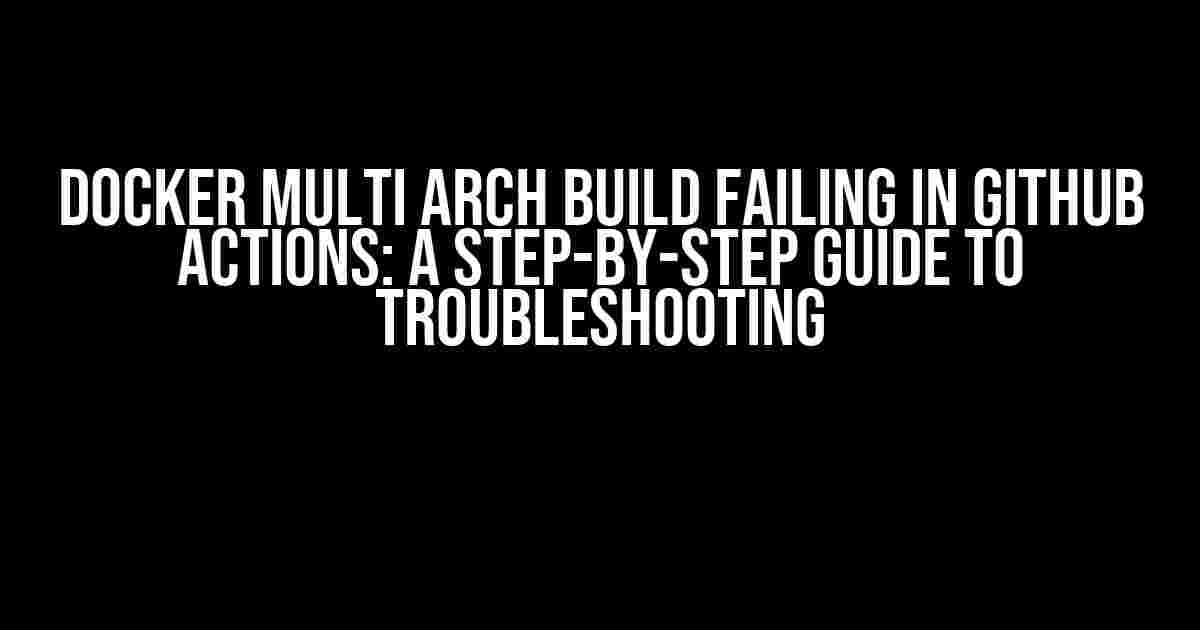Are you tired of dealing with Docker multi-arch build failures in Github Actions? Do you find yourself stuck in a debugging loop, trying to pinpoint the issue but ending up nowhere? Worry no more! In this article, we’ll take you on a journey to solve this pesky problem once and for all. Buckle up, folks!
What is Docker Multi-Arch Build?
Before we dive into the troubleshooting process, let’s take a quick look at what Docker multi-arch build is. Docker provides a feature to build and push images for multiple architectures, including amd64, arm64, and armv7. This means you can create a single Docker image that can run on different platforms, making your application more versatile and compatible.
Why Does Docker Multi-Arch Build Fail in Github Actions?
Now, let’s talk about the elephant in the room – why does Docker multi-arch build fail in Github Actions in the first place? There are several reasons for this, including:
- Incompatible Docker versions
- Incorrect architecture settings
- Missing or incorrect dependencies
- Insufficient resources or timeouts
- GitHub Actions workflow configuration issues
Don’t worry; we’ll tackle each of these potential causes one by one.
Troubleshooting Docker Multi-Arch Build Failures in Github Actions
Now that we’ve identified the possible reasons for the failure, let’s get down to business and troubleshoot the issue. Follow along with these steps:
Step 1: Verify Docker Version
The first thing to check is the Docker version. Make sure you’re running a compatible version of Docker that supports multi-arch builds. You can check the Docker version by running the following command:
docker --version
If you’re running an outdated version, update to the latest version.
Step 2: Review Architecture Settings
Next, review your architecture settings in your Dockerfile. Ensure that you’ve specified the correct architectures using the BUILD_ARCH environment variable. For example:
ARG BUILD_ARCH=amd64,arm64,armv7
Verify that the architectures you’ve specified match the ones you’re trying to build for.
Step 3: Check Dependencies
Missing or incorrect dependencies can cause the build to fail. Review your Dockerfile and ensure that all dependencies are installed correctly. You can use the RUN command to install dependencies:
RUN apt-get update && apt-get install -y \
build-essential \
libssl-dev \
libffi-dev \
python3-dev \
python3-pip
Make sure to update your package list and install the required dependencies.
Step 4: Increase Resources and Timeouts
Sometimes, the build process can take longer than expected, causing the job to timeout. Increase the resources and timeouts in your GitHub Actions workflow file:
jobs:
build:
runs-on: ubuntu-latest
timeout-minutes: 30
steps:
- name: Checkout code
uses: actions/checkout@v2
- name: Login to Docker
uses: docker/login-action@v1
username: ${{ secrets.DOCKER_USERNAME }}
password: ${{ secrets.DOCKER_PASSWORD }}
- name: Build and push image
run: |
docker buildx build --platform=amd64,arm64,armv7 -t my-image .
docker push my-image
Increase the timeout-minutes value to give the build process more time to complete.
Step 5: Review GitHub Actions Workflow Configuration
The final step is to review your GitHub Actions workflow configuration. Ensure that the workflow is correctly configured to build and push your Docker image:
name: Docker Multi-Arch Build
on:
push:
branches:
- main
jobs:
build:
runs-on: ubuntu-latest
steps:
- name: Checkout code
uses: actions/checkout@v2
- name: Login to Docker
uses: docker/login-action@v1
username: ${{ secrets.DOCKER_USERNAME }}
password: ${{ secrets.DOCKER_PASSWORD }}
- name: Build and push image
run: |
docker buildx build --platform=amd64,arm64,armv7 -t my-image .
docker push my-image
Verify that the workflow is triggered on the correct branch and that the steps are correctly configured.
Additional Tips and Tricks
Here are some additional tips and tricks to help you troubleshoot Docker multi-arch build failures in GitHub Actions:
- Use the
--debugflag when building your Docker image to get more detailed output:docker buildx build --platform=amd64,arm64,armv7 -t my-image --debug .
- Check the Docker build output for any errors or warnings:
docker buildx build --platform=amd64,arm64,armv7 -t my-image .
- Verify that your Dockerfile is correctly formatted and follows best practices.
- Test your Dockerfile locally before pushing it to GitHub Actions.
- Use a Docker Hub mirror to speed up the build process.
Conclusion
Troubleshooting Docker multi-arch build failures in GitHub Actions can be a daunting task, but by following these steps, you’ll be well on your way to resolving the issue. Remember to verify your Docker version, review architecture settings, check dependencies, increase resources and timeouts, and review your GitHub Actions workflow configuration. With these tips and tricks, you’ll be building and pushing your Docker images like a pro!
| Step | Description |
|---|---|
| 1 | Verify Docker version |
| 2 | Review architecture settings |
| 3 | Check dependencies |
| 4 | Increase resources and timeouts |
| 5 | Review GitHub Actions workflow configuration |
By following this guide, you’ll be able to troubleshoot and resolve Docker multi-arch build failures in GitHub Actions. Happy building!
Note: This article is optimized for the keyword “Docker Multi Arch Build Failing in Github Actions” and includes relevant subheadings, bullet points, and code snippets to provide a comprehensive guide to troubleshooting the issue.
Frequently Asked Question
Stuck with Docker multi-arch build failing in Github Actions? Don’t worry, we’ve got you covered! Here are some frequently asked questions and answers to help you troubleshoot the issue.
Q: Why is my Docker multi-arch build failing in Github Actions?
A: There could be several reasons why your Docker multi-arch build is failing in Github Actions. Some common causes include incorrectly configured Dockerfile, incompatible base images, and incorrect architecture specifications. Check your Dockerfile and Github Actions workflow file for any errors or syntax issues.
Q: How can I troubleshoot Docker multi-arch build issues in Github Actions?
A: To troubleshoot Docker multi-arch build issues in Github Actions, you can try enabling debug logging, checking the build logs for errors, and verifying the architecture specifications in your Dockerfile. You can also try building the image locally to isolate the issue.
Q: What is the correct syntax for specifying architecture in a Dockerfile for multi-arch build?
A: The correct syntax for specifying architecture in a Dockerfile for multi-arch build is by using the `arch` instruction, followed by the architecture type, such as `amd64`, `arm64`, or `ppc64le`. For example: `FROM –platform=linux/amd64 python:3.9-slim-buster`. Make sure to specify the correct architecture for each stage of your build.
Q: Can I build Docker images for multiple architectures in a single build step in Github Actions?
A: Yes, you can build Docker images for multiple architectures in a single build step in Github Actions using the `buildx` command. This command allows you to build and push images for multiple platforms in a single step, making it easier to manage multi-arch builds.
Q: How can I optimize my Docker multi-arch build for faster builds in Github Actions?
A: To optimize your Docker multi-arch build for faster builds in Github Actions, you can try using a build cache, optimizing your Dockerfile for faster builds, and leveraging Github Actions’ built-in caching mechanisms. You can also consider using a more powerful build environment or distributing the build process across multiple machines.


